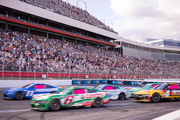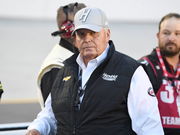
Getty
INDIANAPOLIS, INDIANA – MAY 27: Team owner, Roger Penske of Team Penske looks on during the 108th Indianapolis 500 champion’s portraits at Indianapolis Motor Speedway on May 27, 2024 in Indianapolis, Indiana. (Photo by James Gilbert/Getty Images)

Getty
INDIANAPOLIS, INDIANA – MAY 27: Team owner, Roger Penske of Team Penske looks on during the 108th Indianapolis 500 champion’s portraits at Indianapolis Motor Speedway on May 27, 2024 in Indianapolis, Indiana. (Photo by James Gilbert/Getty Images)
For the first time in nearly seven decades, NASCAR staged a points-paying Cup Series race outside the United States in 2025. The Viva Mexico 250 at Autodromo Hermanos Rodriguez drew massive crowds and showcased the venue’s ability to host world-class stock car racing. However, reports suggest it will not return to the NASCAR schedule in 2026. This is a result of a congested calendar tied to the 2026 FIFA World Cup, which will be partly hosted in the country. That gap leaves an opening in Mexico City’s motorsports landscape, one that Roger Penske’s series has been evaluating closely.
Watch What’s Trending Now!
IndyCar has flirted with a return to Latin America since its last Champ Car race in Mexico in 2007. The series has made international aspirations known before. Yet logistical hurdles and domestic priorities often slowed progress. Now, the combination of an available slot from the NASCAR schedule, a proven venue, and a Mexican star in Pato O’Ward has shifted momentum with Penske Corporation mapping out IndyCar’s next phase.
ADVERTISEMENT
IndyCar set to capitalize on NASCAR schedule change
IndyCar officials recently traveled to Mexico City to review the Autódromo Hermanos Rodríguez and finalize options for a potential 2026 race. As per reports, series leaders are considering either the full Formula 1 Grand Prix circuit or the NASCAR-style layout that bypasses part of the stadium section. The schedule already has a built-in window between March’s new Arlington, Texas street race and April’s Long Beach Grand Prix. This would allow for an international stop without disrupting domestic continuity.
A local promoter, Grupo Rentable, has stepped in to lead negotiations, while CIE-Ocesa could provide additional stability. This is the same company behind Formula 1 and NASCAR events in Mexico. The centerpiece of the push, however, is Pato O’Ward.
Pato O’Ward is a Monterrey native. His success in IndyCar and his fan base at home have created what ESPN has called “Pato-mania.” When NASCAR announced its Mexico City race, O’Ward publicly criticized IndyCar for moving too slowly. He told media outlets, “We can’t wait forever. The fans are ready.” His influence has reportedly helped accelerate talks. Sponsors and promoters see his star power as a guarantee of ticket sales and media. Roger Penske’s backing adds further weight, giving the project credibility that could carry it from discussions to reality.
ADVERTISEMENT
#IndyCar is eyeing a race in #Mexico City as soon as next year – and officials from the series have reportedly been on the ground at Autodromo Hermanos Rodriguez to finalise the details 🇲🇽https://t.co/bwf3Y5oUcH
— Motorsport (@Motorsport) August 20, 2025
Mark Miles, the CEO of Penske Entertainment, said, “It’s too early to declare victory on any of the possibilities that you mentioned, but it is true that both of those markets are a work in progress.”
ADVERTISEMENT
If finalized, IndyCar’s Mexico City return would mark its first Latin American event in nearly 20 years. This would signal a new phase in the series’ global outlook. For Penske, it would also be a strategic move to position IndyCar on equal footing with the NASCAR schedule. Challenges remain, however. Balancing team budgets, securing long-term promoter agreements, and defining the track layout will be difficult. But the opportunity is clearer now than it has been in years. Whether this becomes a cornerstone of IndyCar’s international calendar remains to be seen.
Top Stories
New Charter Deal Triggers ‘Financial Frenzy’ as NASCAR Teams Set for Massive Payday

Rick Hendrick Strikes Fear in NASCAR Fans With Chevy’s New “Illegal” Car

Major Blow to Trackhouse Racing as Team Penske Steals Veteran Crew Chief Back in Unexpected Move

Martin Truex Jr’s Former Crew Chief Ends 12-Year Fight In Huge Personal Announcement

Chevy Team to Enter Kyle Larson’s Series as Michael Jordan Ends NASCAR’s Monopoly

Penske finally gets behind his namesake Porsche’s wheel
Roger Penske, the motorsport titan, recently piloted the Porsche 963 RSP for the very first time on U.S. soil. This car has been his exclusive, one-off hypercar. Built in his honor, this rare machine made its dynamic debut at the Porsche Experience Center Atlanta before roaring onto Monterey Car Week’s stage.
ADVERTISEMENT
The Porsche 963 RSP is more than a bespoke machine. It’s the product of decades of collaboration between Porsche and Roger Penske. Drawing a lineage from the iconic 917 “Count Rossi” street prototype, the car reimagines Porsche’s endurance racing DNA for both road and track. Designed by Porsche’s Sonderwunsch (special request) division, the RSP blends racing pedigree with usability. Yet the details of its craftsmanship and powertrain remain behind the curtain until you dive deeper.
When Penske finally sat behind the wheel, it marked a symbolic moment in a storied partnership. As he reminded, “Our partnership with Porsche has led to an incredible history together built over six decades,” A legacy embodied by this vehicle. The RSP features a twin-turbo 4.6-liter V8 hybrid system tuned to run on pump fuel. It also features higher ride height, functional lighting, and subtle road-legal adjustments. Yet it retains race-bred agility and responsiveness.
With Penske behind the wheel, Porsche has not only immortalized a racing legend but also blurred the line between track prototype and road-legal hypercar. The Porsche Sonderwunsch division has shown what is possible when heritage, art, and engineering converge. While Penske enjoys this masterpiece off-track, the broader question remains. Will Porsche’s street-legal direction influence future offerings?
ADVERTISEMENT
ADVERTISEMENT
ADVERTISEMENT
ADVERTISEMENT

